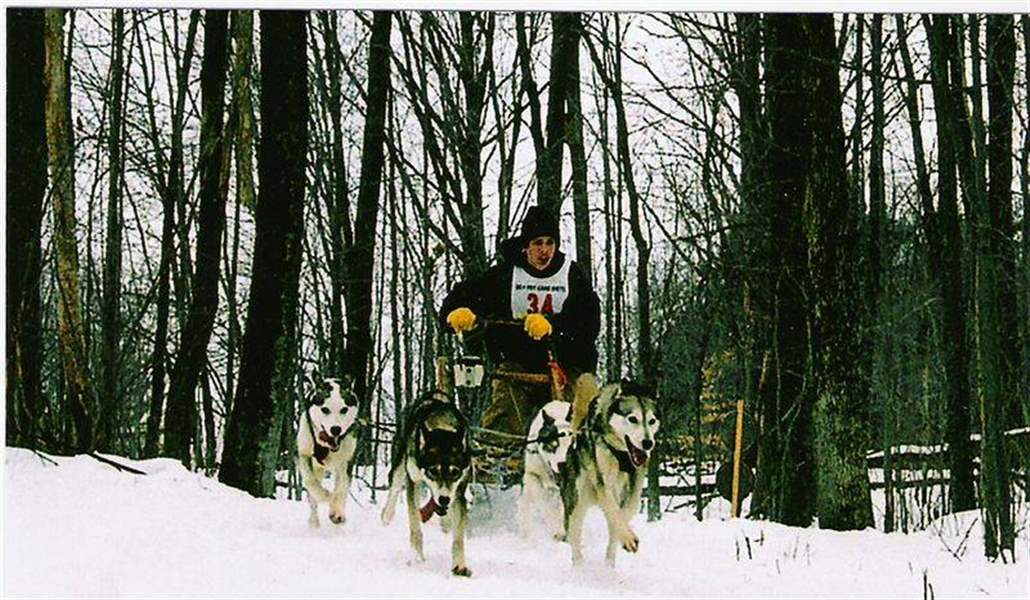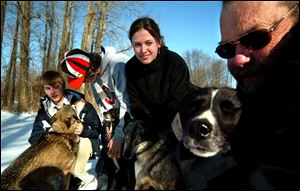
Interest in sled-dog racing runs strong in some families
2/12/2005
Jamie Collier practices with a four-dog team. He will participate in races this weekend in Michigan's Upper Peninsula.

Delta sled-dog racers, from left, Anthony Griffith, Jamie Collier, family friend Stephanie Miler, and Mike Collier, the boys' grandfather, visit their Siberian huskies. The Colliers are one of a half-dozen sled-dog-racing families in the area.
DELTA, Ohio - The only "mush" in Mike and Cherie Collier's world comes served up on a plate at breakfast time.
That might surprise the average observer who counts more than a dozen Siberian huskies penned up in the backyard of their Delta home.
After all, the longtime competitive sled-dog racers would have had to have yelled out the word "mush" to their team of dogs sometime during their career.
"●'All right' means get prepared, 'let's go' means get moving, and 'whoa' is to stop," said Mr. Collier, who began racing dogs in the late 1950s. "Dogs are like children. The more you yell at them, the less likely they are to listen."
That's a lesson the Colliers have learned over more than 40 years from their relationships with more than 100 dogs.

Jamie Collier practices with a four-dog team. He will participate in races this weekend in Michigan's Upper Peninsula.
Mr. Collier, 59, a retired maintenance employee at a local hospital, harnessed his first dog in 1956. By 1972, he was taking his family to various sled-dog races in the area. It was a family sport, one that his two daughters started shortly after learning to walk.
And now it has trickled down to the third generation. This weekend the Colliers will be trucking up to Michigan's Upper Peninsula with 16 dogs, their teenage grandsons, and a friend of the family who they've hooked on sled-dog racing.
Grandson Anthony Griffith, 15, will race a six-dog team while grandson Jamie Collier, 14, will lead a team of four dogs. Stephanie Miler, a 16-year-old friend of the family, is driving a team of four dogs as well.
"Last year we made a concerted effort to get smaller," Mr. Collier said. "But the grandkids begged and begged so our cutting down ended up going from 18 dogs to 16."
It indicates that once a driver enters the world of sled-dog racing, he said, it's tough to quit.
Just ask Dale and Nancy Wolfe of Delta who, after 25 years of sled-dog racing, now have about 40 dogs.
They are not alone.
Locally, there are a half dozen or so families involved in the dog racing community, Mr. Wolfe said.
Though the sport is popular in certain circles, Mr. Wolfe said, many people don't know there is more to sled-dog racing than Alaska's famous Iditarod, a 1,200-mile race held each year.
"It's kind of an invisible sport. It's not viewer-friendly because it takes place in the middle of the winter when it's cold," said Mr. Wolfe, 58, who determined that there was enough snow on the Drummond Island trails.
According to the International Sled Dog Racing Association based in Minnesota, there are an estimated 20,000 sled-dog racers worldwide. More than 6,000 drivers live in the United States and Canada.
Sled-dog racers come from all walks of life and are a variety of ages, although the association reports that nearly half of all competitors are between 40 and 60 years old.
The Colliers' youngest daughter, Lisa Griffith, 31, said that it was a natural sport for her to follow her parents into. In similar fashion, it was easy for her son to become entwined in sled-dog racing, too.
"Freedom," she said of the experience. "You feel free when you're out there."
Like many involved in the sport, the Colliers have heard the concerns of critics who feel that it is cruel to the dogs. The only cruel aspects of owning Siberian huskies is to keep them from running, Mr. Collier responded.
Outside in the fenced-in area where the dogs - both active and retired - live, Mr. and Mrs. Collier walked among the barking dogs yesterday. While Mr. Collier lovingly rubbed the face of Onyx, Mrs. Collier walked to each of the pens and stroked the snouts of each dog.
"There," she said when finished. "Everybody got a nose rub."
Contact Erica Blake at:
eblake@theblade.com
or 419-724-6076.